Merit Order Effect Modeling: The Case of the Hellenic Electricity Market
Abstract
1. Introduction
2. Merit Order Effect and the Hellenic Electricity Market
3. Day-Ahead Electricity Market Model
3.1. Definition of the Merit Order Effect
3.2. The Merit Order Curve
- GWh/h the maximum feasible electricity supply;
- €/MWh the electricity price at half of maximum supply;
- - empirical shape constant.
3.3. The Electricity Demand
- GWh/year the total electricity demand during the year;
- - the portion of the total annual demand for winter activities;
- - the portion of the total annual demand for summer activities;
- days the time of the peak of winter activities;
- days the time of the peak of summer activities;
- days the typical duration of the winter activities;
- days the typical duration of the summer activities.
- - the portion of the total daily demand for noon activities;
- - the portion of the total daily demand for evening activities;
- hours the time of the peak of noon activities;
- hours the time of the peak of evening activities;
- hours the typical duration of the noon activities;
- hours the typical duration of the evening activities.
3.4. Renewable Electricity Production
- i days the day of the year (1, 2, …, 365);
- GWh/day the electricity generated from renewables during the day i;
- GWh/day the electricity generated from renewables except photovoltaics during the day i;
- GWh/day the electricity generated from photovoltaics during the day i.
- GWh/year the total annual electricity generated by renewables except photovoltaics;
- GWh/day the seasonal variation amplitude of renewables except photovoltaics;
- days the day of minimum production for renewables except photovoltaics.
- GWh/year the total annual electricity generated by photovoltaics;
- GWh/day the seasonal variation amplitude of photovoltaics;
- days the day with the minimum production for photovoltaics.
- hours the hour with maximum production from photovoltaics.
3.5. Regression Analysis
- Equations (2) and (3) are simultaneous fitted to real data of demand;
- Equations (5)–(8) are simultaneous fitted to real data of renewable electricity generation;
- Equation (1) is fitted to real data of system marginal price and virtual marginal price.
- GWh/h Hourly electricity demand;
- GWh/h Hourly renewables electricity;
- €/MWh Hourly system marginal price;
- €/MWh Hourly virtual system marginal price.
- GWh/h the maximum feasible electricity supply;
- GWh/year the total annual electricity generated by renewables except photovoltaics;
- GWh/year the total annual electricity generated by photovoltaics;
- GWh/year the total electricity demand during the year.
4. Results and Discussion
4.1. Statistical Analysis
4.2. Regression Analysis
- GWh/h the maximum feasible electricity supply;
- GWh/year the total annual electricity generated by renewables except photovoltaics;
- GWh/year the total annual electricity generated by photovoltaics;
- GWh/year the total electricity demand during the year.
- Estimated values of and are exactly as recorded 51.9 TWh/y and 3.72 TWh/y, respectively, while estimated value of is a little higher than recorded 5.84 TWh/y;
- Smax of 9.88 GWh/h is a decline from the expected installed conventional power of 12 GW, because the total capacity does not participate continuously into the market.
4.3. Sensitivity Analysis
- GWh/h the maximum feasible electricity supply;
- GWh/year the total annual electricity generated by renewables except photovoltaics;
- GWh/year the total annual electricity generated by photovoltaics;
- GWh/year the total electricity demand during the year.
- D Demand is increased, all other factors are kept constant;
- D + R Demand and renewables are increased by the same rate and conventionals are kept constant;
- D + C Demand and conventionals are increased with the same rate and renewables are kept constant;
- A All factors are increased by the same rate;
- A − D All factors except Demand are increased by the same rate.
5. Conclusions
Author Contributions
Funding
Conflicts of Interest
Nomenclature
| the correction factor (-) | |
| the portion of the total daily demand for evening activities (-) | |
| the electricity demand during the day i (GWh/day) | |
| the electricity demand during the hour j of the day i (GWh/hour) | |
| the portion of the total daily demand for noon activities (-) | |
| the portion of the total annual demand for summer activities (-) | |
| the total electricity demand during the year (GWh/year) | |
| the portion of the total annual demand for winter activities (-) | |
| the day of the year (1, 2, …, 365) (days) | |
| the day with the minimum production for photovoltaics (days) | |
| the day of minimum production for renewables except photovoltaics (days) | |
| the hour with maximum production from photovoltaics (hours) | |
| the hour with maximum production from photovoltaics (hours) | |
| empirical shape constant (-) | |
| the supply price (€/MWh) | |
| the electricity generated from photovoltaics during the day i (GWh/day) | |
| the electricity generated from photovoltaics during the hour j of the day i (GWh/hour) | |
| the electricity price at half of maximum supply (€/MWh) | |
| the total annual electricity generated by photovoltaics (GWh/year) | |
| the electricity generated from renewables during the day i (GWh/day) | |
| the electricity generated from renewables during the hour j of the day i (GWh/hour) | |
| the dispatchable electricity supply (GWh/h) | |
| the maximum feasible electricity supply (GWh/h) | |
| the System Marginal Price (€/MWh) | |
| the System Marginal Price during the hour j of the day i (€/MWh) | |
| the time of the peak of evening activities (hours) | |
| the time of the peak of noon activities (hours) | |
| the time of the peak of summer activities (days) | |
| the time of the peak of winter activities (days) | |
| the Virtual System Marginal Price (€/MWh) | |
| the Virtual System Marginal Price during the hour j of the day i (€/MWh) | |
| the electricity generated from renewables except photovoltaics during the day i (GWh/day) | |
| the electricity generated from renewables except photovoltaics during the hour j of the day i (GWh/hour) | |
| the total annual electricity generated by renewables except photovoltaics (GWh/year) | |
| the seasonal variation amplitude of photovoltaics (GWh/day) | |
| the typical duration of the evening activities (hours) | |
| the typical duration of the noon activities (hours) | |
| the typical duration of the summer activities (days) | |
| the typical duration of the winter activities (days) | |
| the seasonal variation amplitude of renewables except photovoltaics (GWh/day) |
Abbreviations
| A | all |
| C | conventionals |
| CO2 | carbon dioxide |
| D | demand |
| DAM | day-ahead market |
| DR | demand minus renewables |
| ETMEAR | surcharge on electricity price (Greek abbreviation) |
| FIP | feed-in premium |
| FIT | feed-in Tariff |
| MOC | merit order curve |
| MOE | merit order effect |
| PVs | photovoltaics |
| PXEFEL | merit order effect charge (Greek abbreviation) |
| R | renewables |
| RAE | regulatory authority of energy |
| RES | renewable energy sources |
| SMP | system marginal price |
| VSMP | virtual system marginal price |
| W | renewables except photovoltaics |
References
- Cludius, J.; Forrest, S.; MacGill, I. Distributional effects of the Australian Renewable Energy Target (RET) through wholesale and retail electricity price impacts. Energy Policy 2014, 71, 40–51. [Google Scholar] [CrossRef]
- Cludius, J.; Hermann, H.; Matthes, F.C.; Graichen, V. The merit order effect of wind and photovoltaic electricity generation in Germany 2008–2016 estimation and distributional implications. Energy Econ. 2014, 44, 302–313. [Google Scholar] [CrossRef]
- Clò, S.; Cataldi, A.; Zoppoli, P. The merit-order effect in the Italian power market: The impact of solar and wind generation on national wholesale electricity prices. Energy Policy 2015, 77, 79–88. [Google Scholar] [CrossRef]
- Traber, T.; Kemfert, C. Gone with the wind? Electricity market prices and incentives to invest in thermal power plants under increasing wind energy supply. Energy Econ. 2011, 33, 249–256. [Google Scholar] [CrossRef]
- McConnell, D.; Hearps, P.; Eales, D.; Sandiford, M.; Dunn, R.; Wright, M.; Bateman, L. Retrospective modeling of the merit-order effect on wholesale electricity prices from distributed photovoltaic generation in the Australian National Electricity Market. Energy Policy 2013, 58, 17–27. [Google Scholar] [CrossRef]
- Weigt, H. Germany’s wind energy: The potential for fossil capacity replacement and cost saving. Appl. Energy 2009, 86, 1857–1863. [Google Scholar] [CrossRef]
- De Miera, G.S.; del Río González, P.; Vizcaíno, I. Analysing the impact of renewable electricity support schemes on power prices: The case of wind electricity in Spain. Energy Policy 2008, 36, 3345–3359. [Google Scholar] [CrossRef]
- Sensfuß, F.; Ragwitz, M.; Genoese, M. The merit-order effect: A detailed analysis of the price effect of renewable electricity generation on spot market prices in Germany. Energy Policy 2008, 36, 3086–3094. [Google Scholar] [CrossRef]
- Ciarreta, A.; Espinosa, M.P.; Pizarro-Irizar, C. Is green energy expensive? Empirical evidence from the Spanish electricity market. Energy Policy 2014, 69, 205–215. [Google Scholar] [CrossRef]
- Gelabert, L.; Labandeira, X.; Linares, P. An ex-post analysis of the effect of renewables and cogeneration on Spanish electricity prices. Energy Econ. 2011, 33, S59–S65. [Google Scholar] [CrossRef]
- Jónsson, T.; Pinson, P.; Madsen, H. On the market impact of wind energy forecasts. Energy Econ. 2010, 32, 313–320. [Google Scholar] [CrossRef]
- Forrest, S.; MacGill, I. Assessing the impact of wind generation on wholesale prices and generator dispatch in the Australian National Electricity Market. Energy Policy 2013, 59, 120–132. [Google Scholar] [CrossRef]
- Woo, C.K.; Horowitz, I.; Moore, J.; Pacheco, A. The impact of wind generation on the electricity spot-market price level and variance: The Texas experience. Energy Policy 2011, 39, 3939–3944. [Google Scholar] [CrossRef]
- Lu, P.; Pr, J.; Janda, K. The merit order effect of Czech photovoltaic plants. Energy Policy 2017, 106, 138–147. [Google Scholar] [CrossRef]
- Aineto, D.; Iranzo-Sánchez, J.; Lemus-Zúñiga, L.G.; Onaindia, E.; Urchueguía, J.F. On the influence of renewable energy sources in electricity price forecasting in the Iberian market. Energies 2019, 12, 2082. [Google Scholar] [CrossRef]
- Eurostat. Europe 2020 targets: Statistics and indicators for Greece. In Share of Renewable Energy; European Commission: Brussels, Belgium, 2019; Available online: https://ec.europa.eu (accessed on 4 September 2019).
- Giannini, E.; Moropoulou, A.; Maroulis, Z.; Siouti, G. Penetration of Photovoltaics in Greece. Energies 2015, 8, 6497–6508. [Google Scholar] [CrossRef]
- Karteris, M.; Papadopoulos, A.M. Legislative framework for photovoltaics in Greece: A review of the sector’s development. Energy Policy 2013, 55, 296–304. [Google Scholar] [CrossRef]
- Simoglou, C.K.; Member, S.; Biskas, P.N.; Zoumas, C.E.; Bakirtzis, A.G.; Member, S. Evaluation of the Impact of RES Integration on the Greek Electricity Market by Mid-term Simulation. In Proceedings of the 2011 IEEE Trondheim PowerTech, Trondheim, Norway, 19–23 June 2011; pp. 1–8. [Google Scholar]
- Simoglou, C.K.; Biskas, P.N.; Bakirtzis, A.G. Impact of Increased RES Penetration on the Operation of the Greek Electricity Market. In Proceedings of the 7th Mediterranean Conference and Exhibition on Power Generation, Transmission, Distribution and Energy Conversion, Agia Napa, Cyprus, 7–10 November 2010; Available online: https://ieeexplore.ieee.org/document/5716014 (accessed on 4 September 2019).
- Electricity Production from Renewable Energy Sources and High Efficiency Cogeneration of Heat and Power, and Other Provisions. Law 3468/2006, Government Gazette A129, Greece. 2006. Available online: http://www.et.gr/index.php/anazitisi-fek (accessed on 29 October 2019).
- New Support Scheme for Power Plants from Renewable Energy Sources and High Efficiency Cogeneration of Heat and Power. Law 4414/2016, Government Gazette A149, Greece. 2016. Available online: http://www.et.gr/index.php/anazitisi-fek (accessed on 29 October 2019).
- Liberalization of Electricity Market. Regulation of Energy Policy Issues and Other Provissions. Law 2773/1999, Government Gazette A286, Greece. 1999. Available online: http://www.et.gr/index.php/anazitisi-fek (accessed on 29 October 2019).
- Ratification of Mid-term Fiscal Strategy 2013–2016—Urgent Regulations Relating to the Implementation of Law 4046/2012 and the Midterm Fiscal Strategy 2013–2016. Law 4093/2012, Government Gazette A222, Greece. 2012. Available online: http://www.et.gr/index.php/anazitisi-fek (accessed on 29 October 2019).
- Emergency Measures for the Application of Laws 3919/2011, 4093/2012 and 4127/2013. Law 4152/2013, Government Gazette A107, Greece. 2013. Available online: http://www.et.gr/index.php/anazitisi-fek (accessed on 29 October 2019).
- Support Measures for the Stabilization and Development of Greek Economy and Other Provisions. Law 4254/2014, Government Gazette A85, Greece. 2014. Available online: http://www.et.gr/index.php/anazitisi-fek (accessed on 29 October 2019).
- Approval of RES Administrator and Guarantees of Origin Code according to paragraph 3 of art 117E of Law 4001/2011; Decision N°509/2018; Government Gazette B2307: Greece, 2018.
- Electricity Exchange Code, 5.3 ed.; Energy Exchange (EnEx) Group: Athens, Greece, 2019; Available online: http://www.enexgroup.gr/fileadmin/groups/EDRETH/Manuals/20190910_KSIE_Ekdosi_5.3.pdf (accessed on 29 October 2019).
- Modification of Electricity Exchange Code and Electricity Exchange Code Manual, According to the Provisions of Paragraph 3.a, (bb) of Article 143 and Law 4001/2011; RAE Decision No 334/2016; Government Gazette B3169: Greece, 2016.
- Bello, A.; Bunn, D.W.; Reneses, J.; Munoz, A. Medium-Term Probabilistic Forecasting of Electricity Prices: A Hybrid Approach. IEEE Trans. Power Syst. 2017, 32, 334–343. [Google Scholar] [CrossRef]
- Loumakis, S.; Giannini, E.; Maroulis, Z. Renewable Energy Sources Penetration in Greece: Characteristics and Seasonal Variation of the Electricity Demand Share Covering. Energies 2019, 12, 2441. [Google Scholar] [CrossRef]
- Hellenic Electricity Market Operator. Houlry Day Ahead Market Data. Available online: http://www.lagie.gr (accessed on 7 January 2018).
- Hellenic Energy Exchange Group. Houlry Day Ahead Market Data. Available online: http://www.enexgroup.gr (accessed on 8 September 2019).

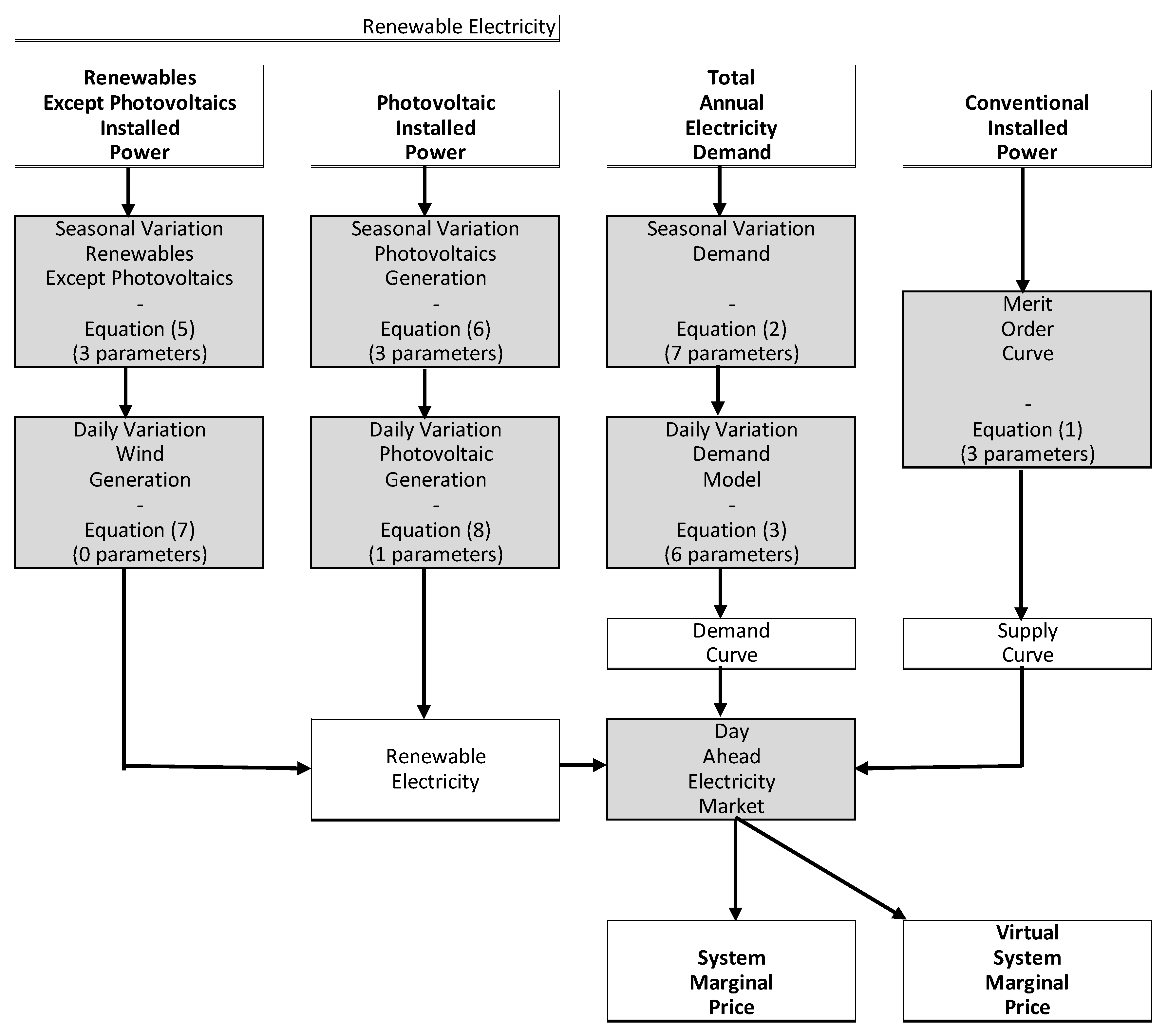
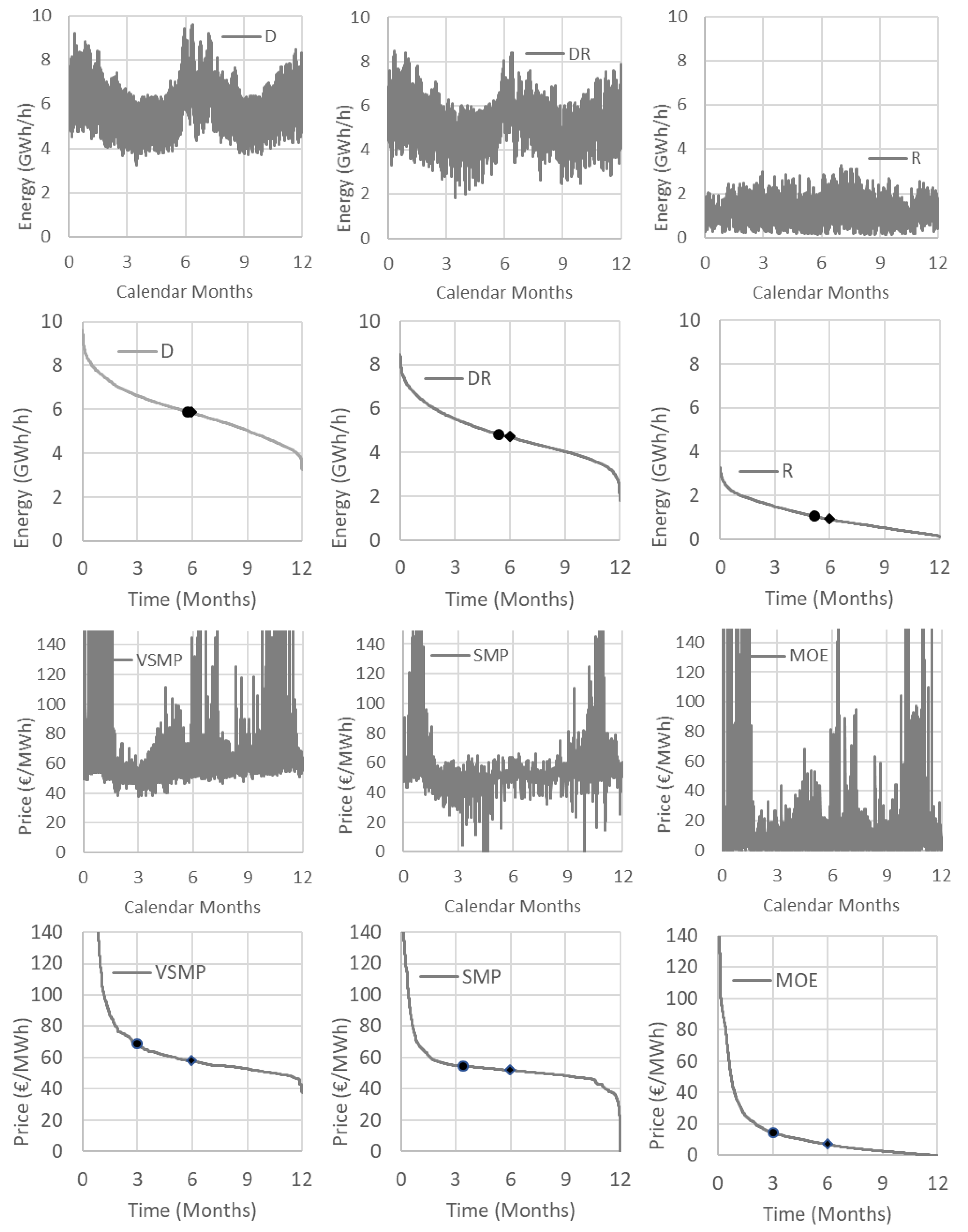
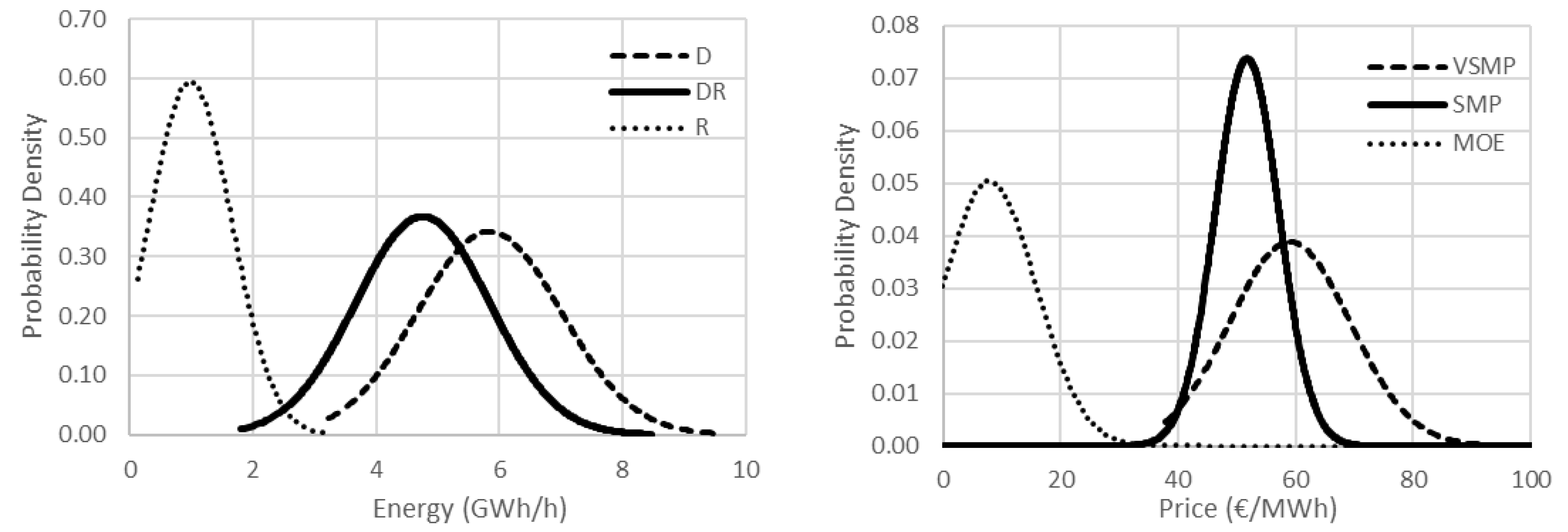
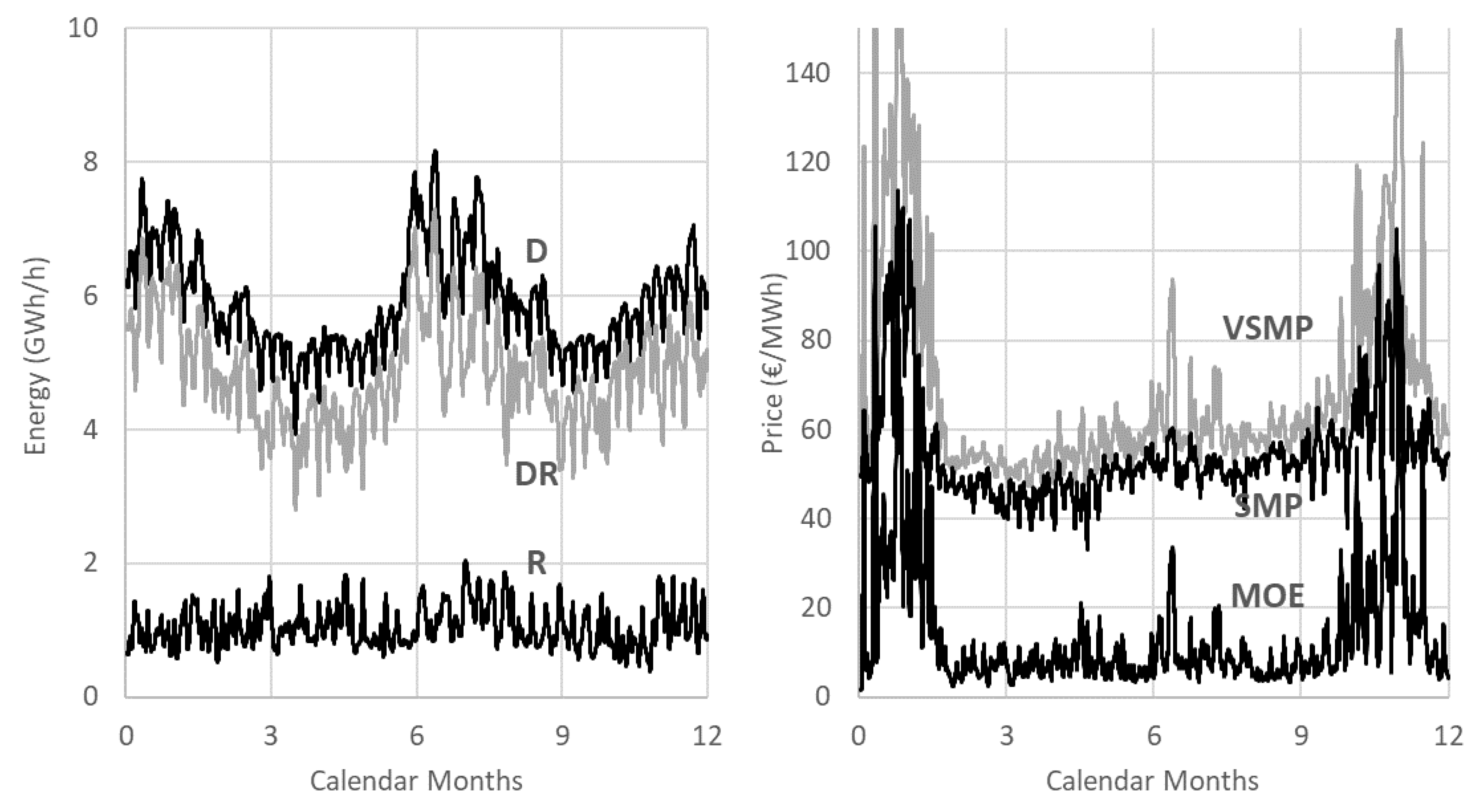
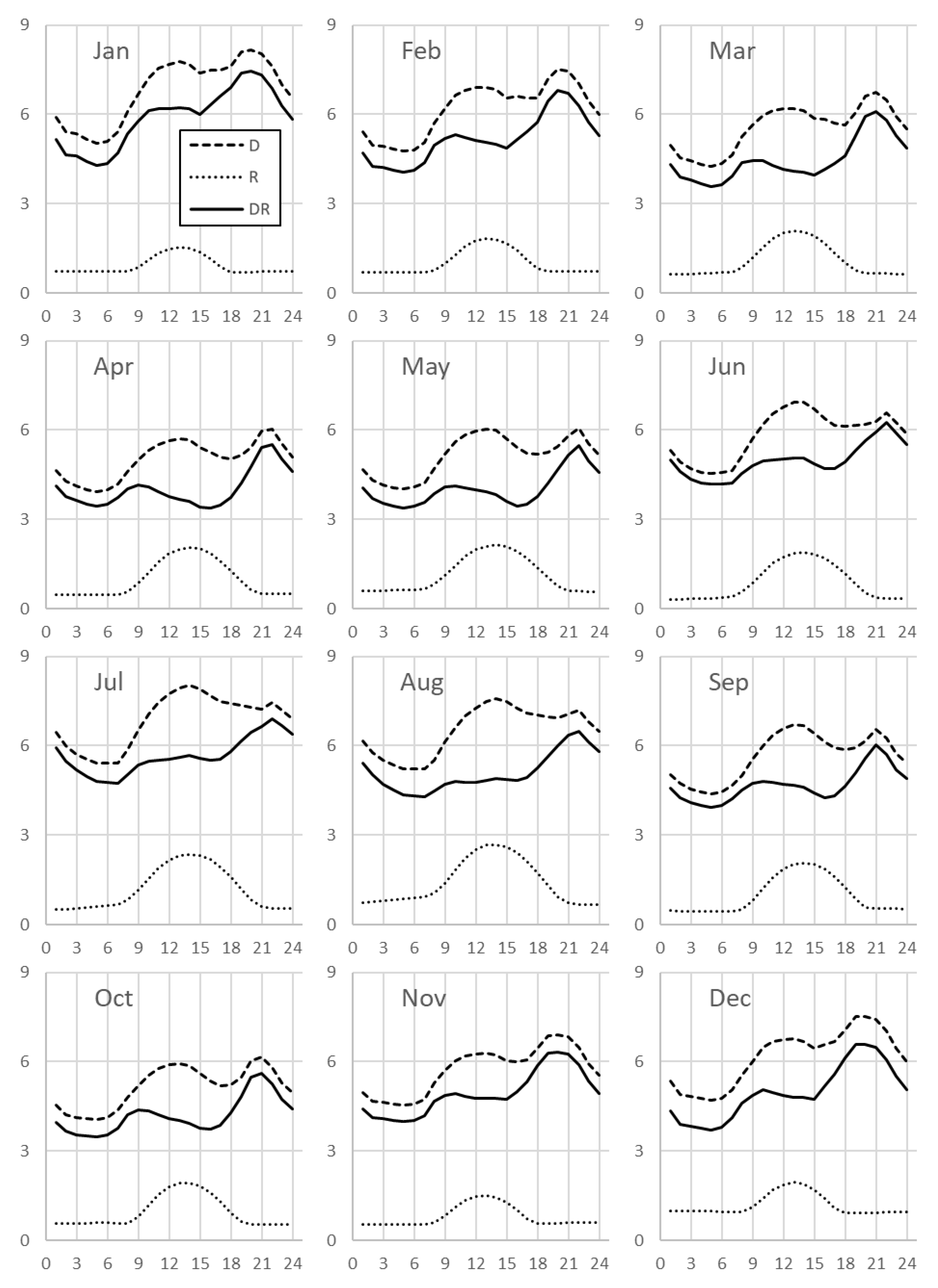
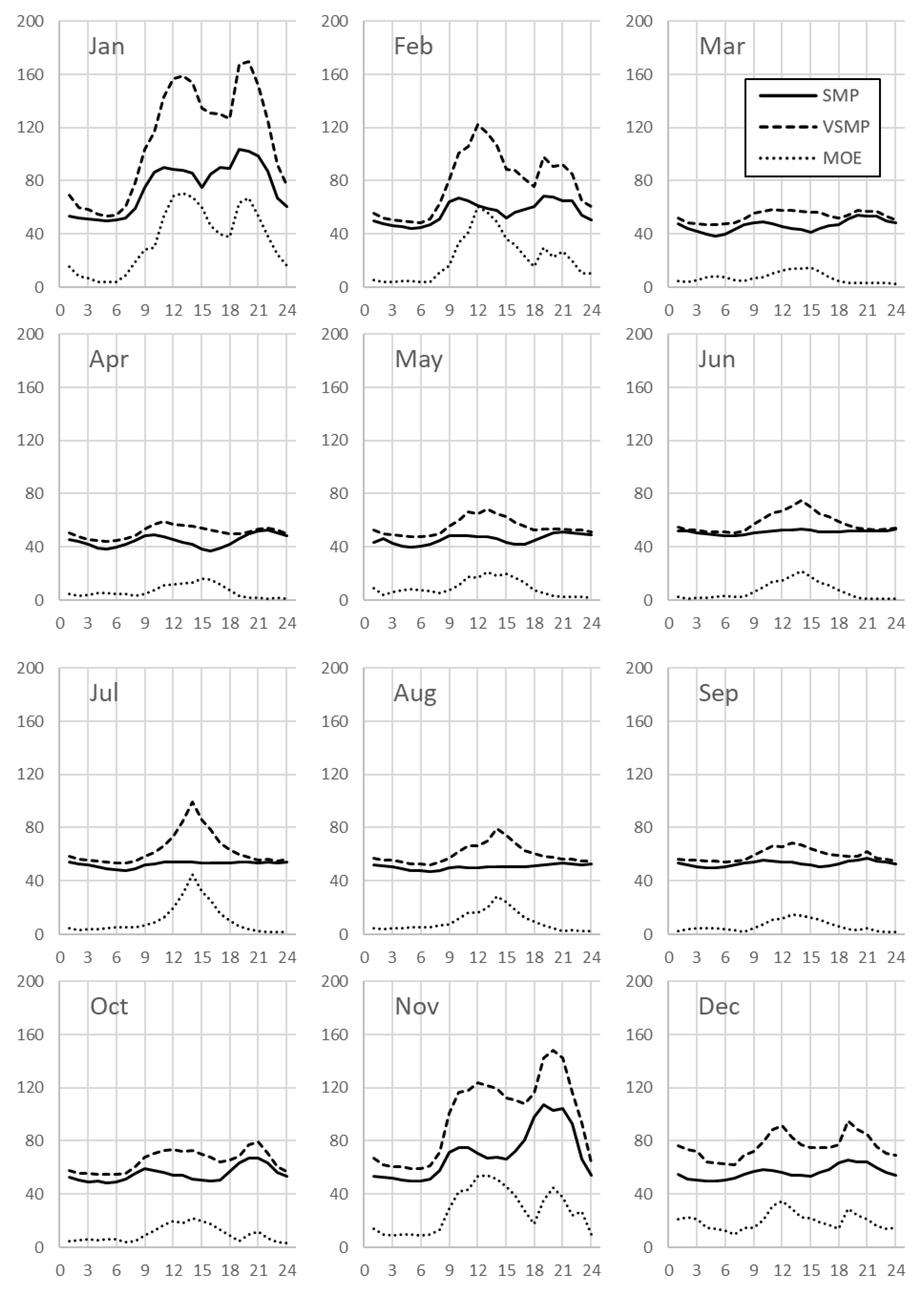


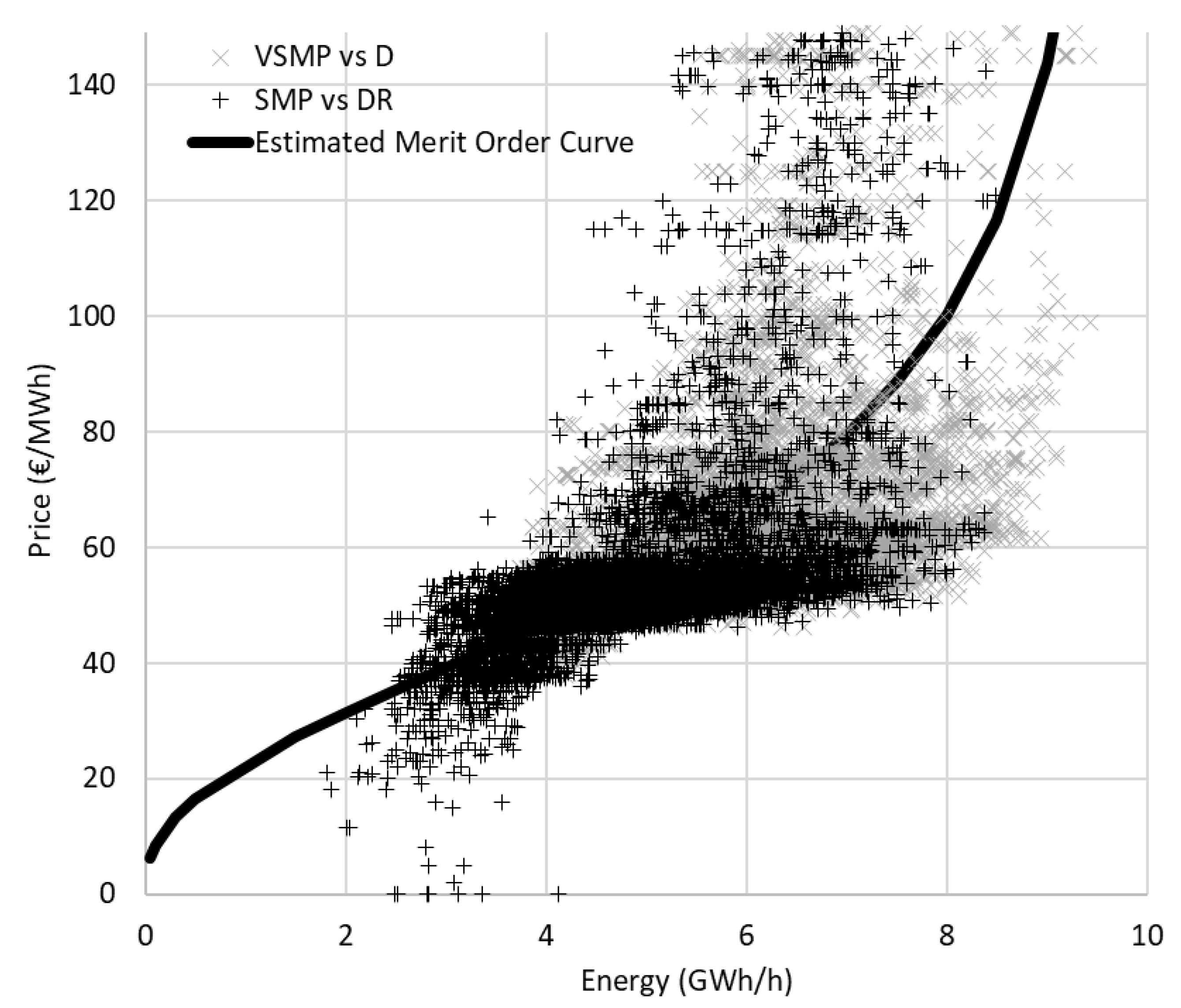
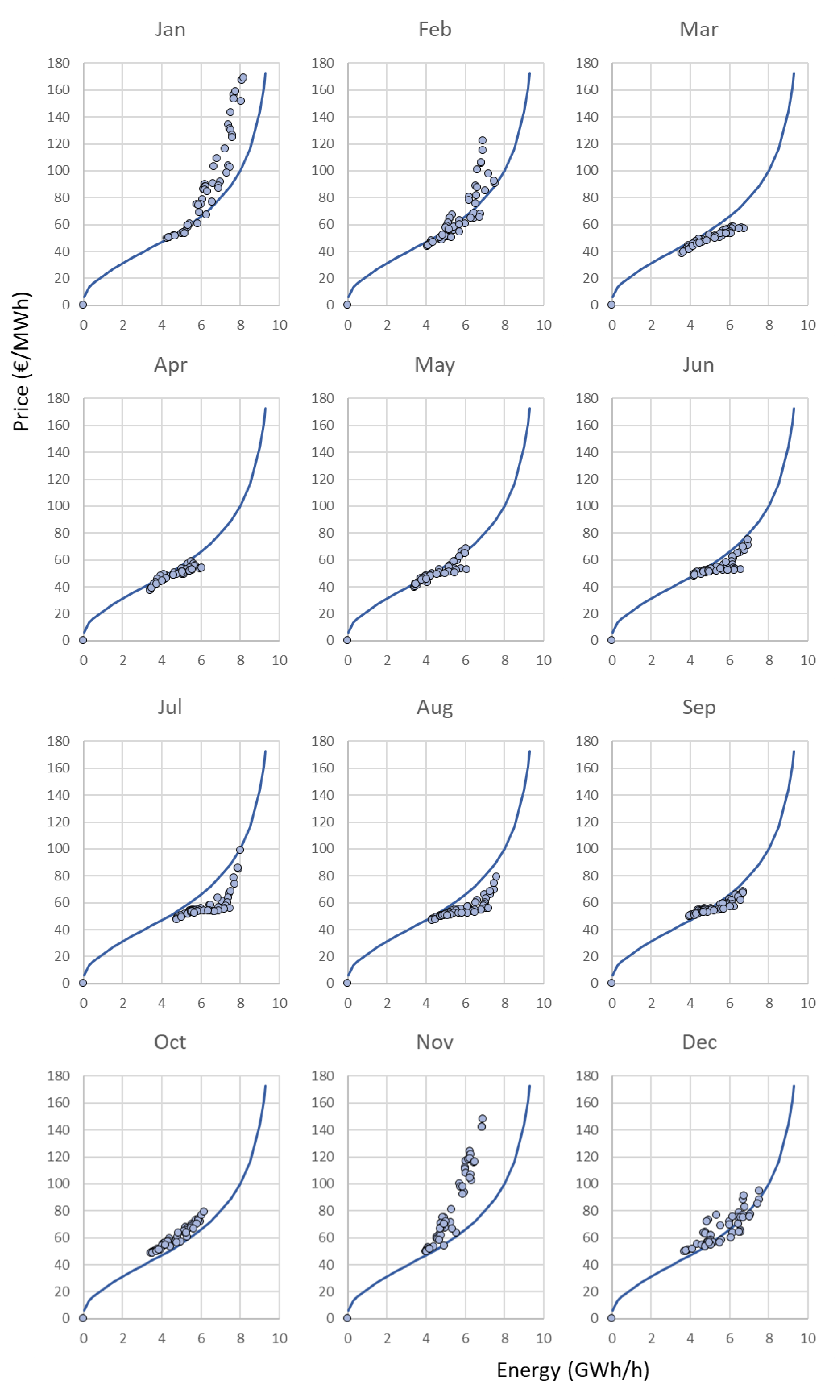
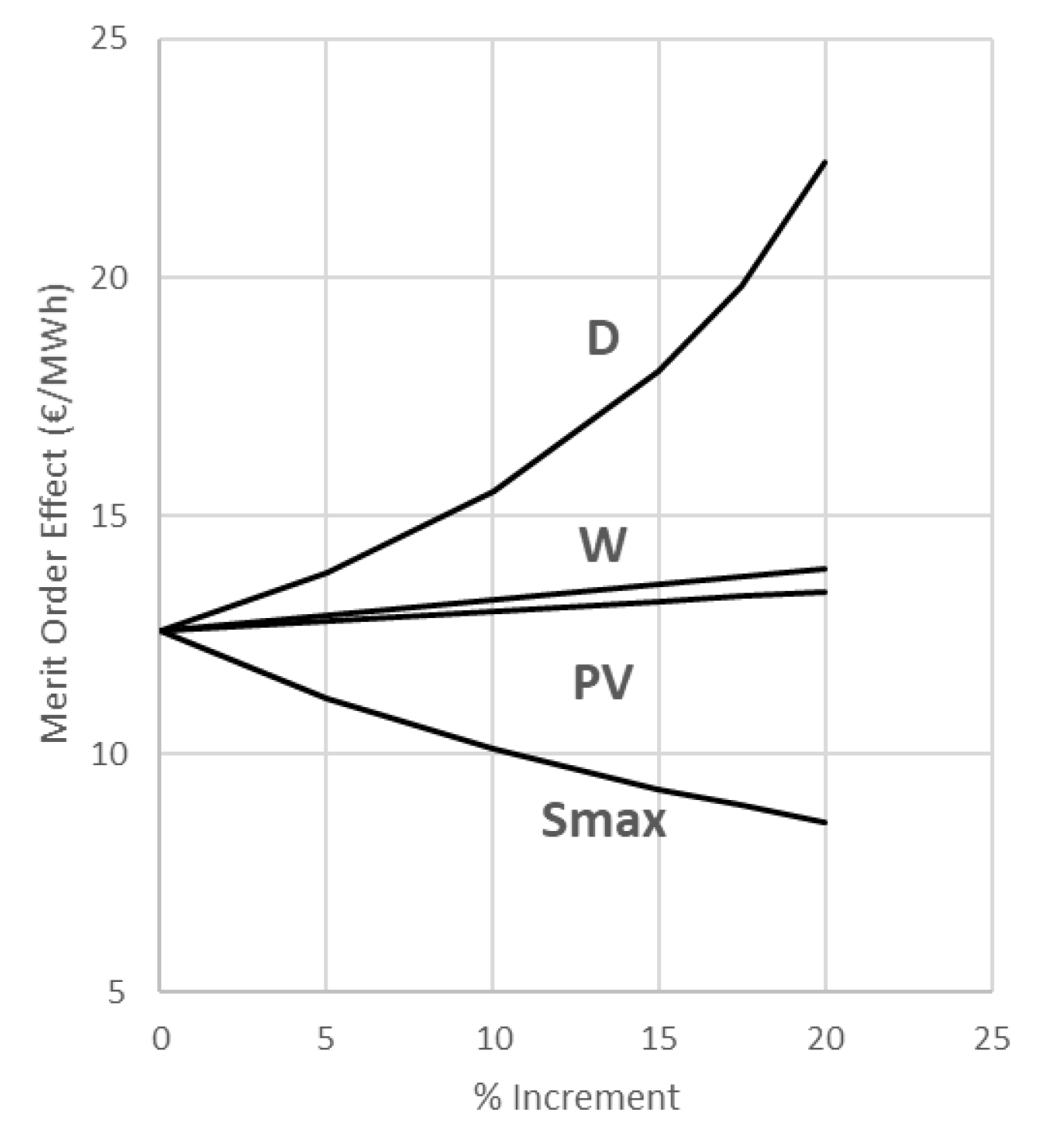
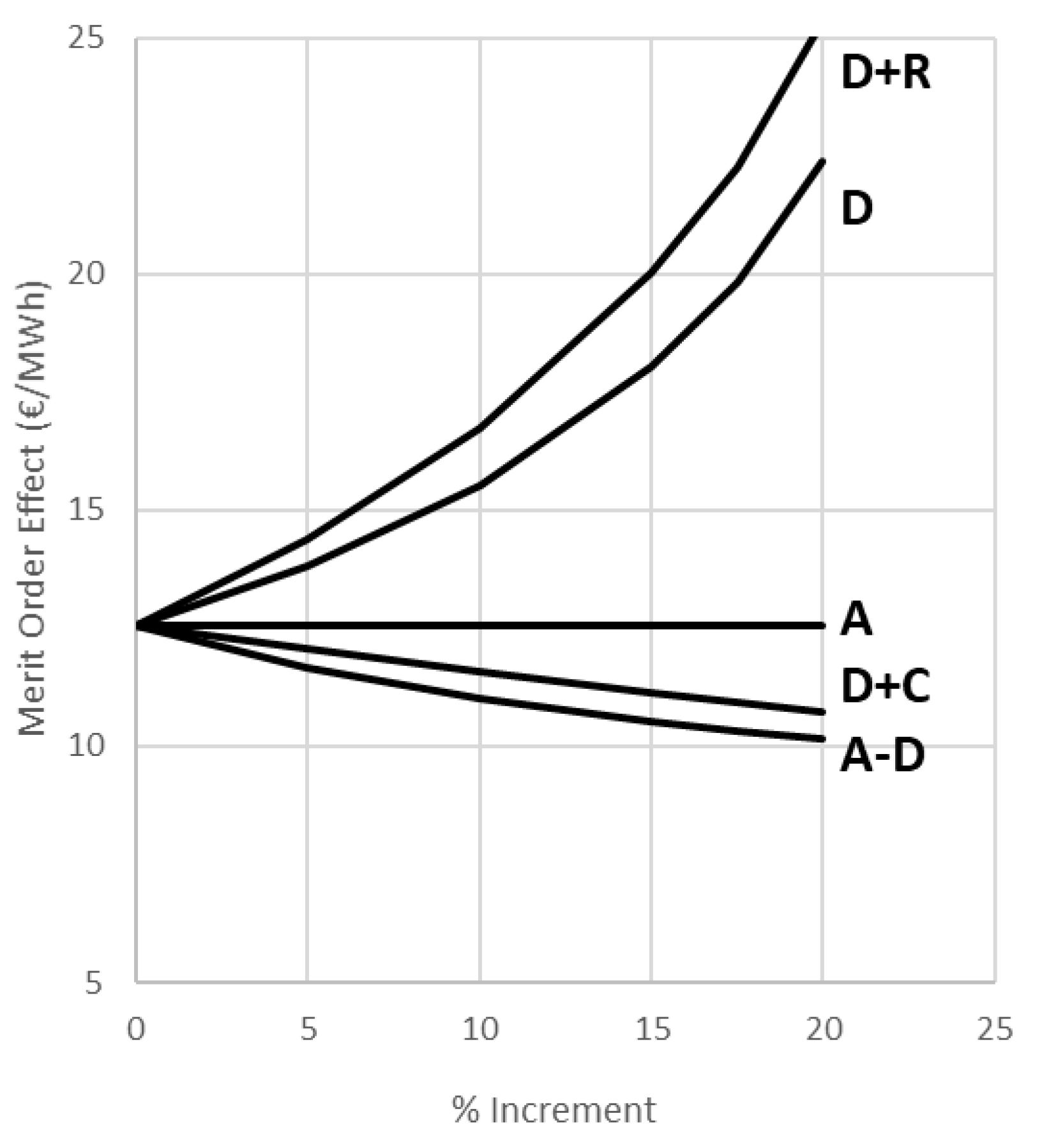
| Variable | Symbol | St Dev | Mean | Median | Min | Max | Units |
|---|---|---|---|---|---|---|---|
| Demand | D | 1.13 | 5.89 | 5.84 | 3.24 | 9.61 | GWh/h |
| Demand renewables | DR | 1.09 | 4.84 | 4.70 | 1.81 | 8.48 | GWh/h |
| Renewables | R | 0.64 | 1.05 | 0.91 | 0.12 | 3.29 | GWh/h |
| Virtual system marginal price | VSMP | 33.9 | 68.8 | 57.6 | 37.8 | >150 | €/MWh |
| System marginal price | SMP | 16.8 | 54.7 | 51.7 | 0.0 | >150 | €/MWh |
| Merit order effect | MOE | 24.5 | 14.2 | 6.9 | 0.0 | >150 | €/MWh |
| Merit Order Curve Parameters | Equation (1) | Units | |
| Price at half of maximum supply | Pmed | 55.2 | €/MWh |
| Maximum feasible electricity supply | Smax | 9.88 | GWh/h |
| Empirical shape constant | n | 0.412 | - |
| Demand Seasonal Variation Parameters | Equation (2) | ||
| Annual demand | DT | 51.6 | TWh/y |
| Winter activities fraction | dw | 0.099 | - |
| Winter activities peak day | two | 13.1 | days |
| Winter activities standard period | Δtw | 44.5 | days |
| Summer activities fraction | ds | 0.085 | - |
| Summer activities peak day | tso | 205 | days |
| Summer activities standard period | Δts | 33.3 | days |
| Demand Daily Variation Parameters | Equation (3) | ||
| Noon activities fraction | dn | 0.147 | - |
| Noon activities peak hour | tno | 12.5 | h |
| Noon activities standard period | Δtn | 3.38 | h |
| Evening activities fraction | de | 0.127 | - |
| Evening activities peak hour | teo | 21.1 | h |
| Evening activities standard period | Δte | 3.03 | h |
| Renewable Electricity Variation Parameters | Equations (5)–(8) | ||
| Annual production of other renewables | WT | 5.48 | TWh/y |
| Seasonal relative variation of other renewables | ΔW | 0.00 | - |
| Other renewables generation peak day | iwo | 0.00 | days |
| Annual production of photovoltaics | PVT | 3.71 | TWh/y |
| Seasonal relative variation of photovoltaics | ΔPV | 0.294 | - |
| Photovoltaics production minimum day | iPVo | 3.58 | days |
| Photovoltaic production peak hour | jPVo | 13.7 | h |
© 2019 by the authors. Licensee MDPI, Basel, Switzerland. This article is an open access article distributed under the terms and conditions of the Creative Commons Attribution (CC BY) license (http://creativecommons.org/licenses/by/4.0/).
Share and Cite
Loumakis, S.; Giannini, E.; Maroulis, Z. Merit Order Effect Modeling: The Case of the Hellenic Electricity Market. Energies 2019, 12, 3869. https://doi.org/10.3390/en12203869
Loumakis S, Giannini E, Maroulis Z. Merit Order Effect Modeling: The Case of the Hellenic Electricity Market. Energies. 2019; 12(20):3869. https://doi.org/10.3390/en12203869
Chicago/Turabian StyleLoumakis, Stelios, Eugenia Giannini, and Zacharias Maroulis. 2019. "Merit Order Effect Modeling: The Case of the Hellenic Electricity Market" Energies 12, no. 20: 3869. https://doi.org/10.3390/en12203869
APA StyleLoumakis, S., Giannini, E., & Maroulis, Z. (2019). Merit Order Effect Modeling: The Case of the Hellenic Electricity Market. Energies, 12(20), 3869. https://doi.org/10.3390/en12203869





